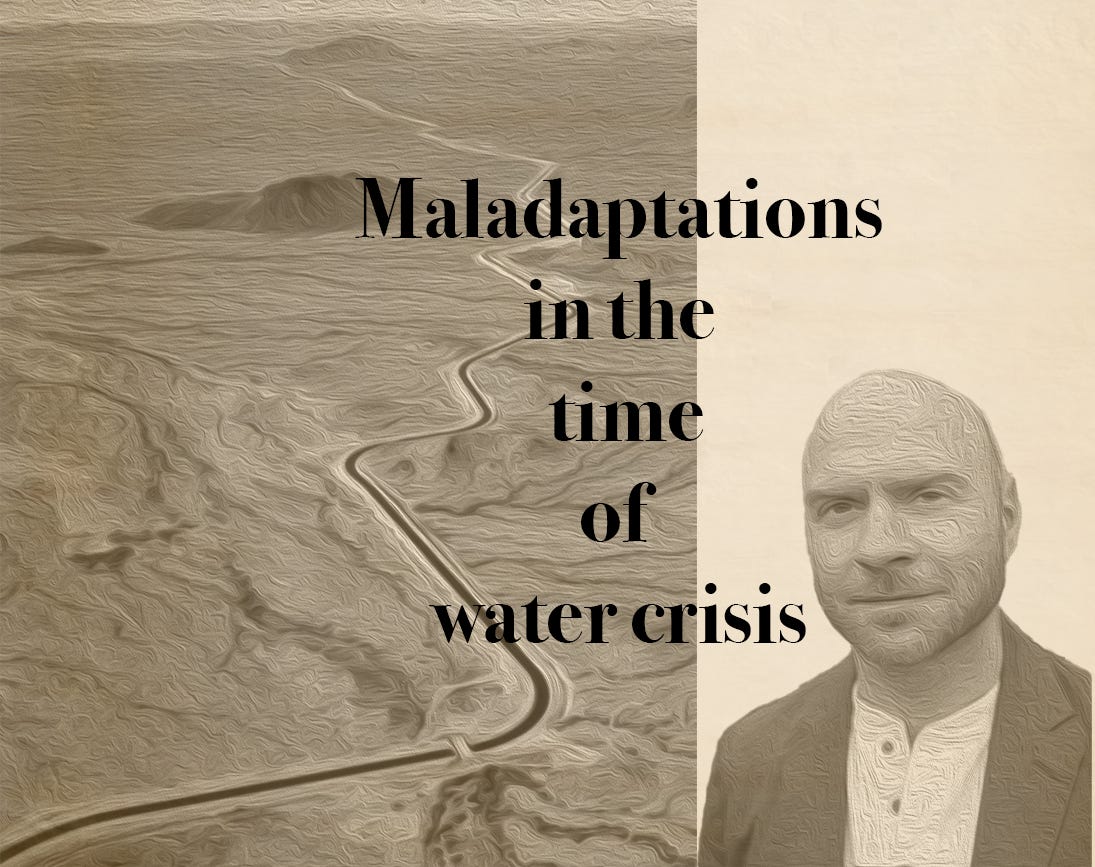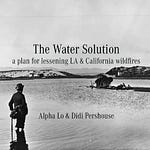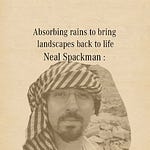Maladaptation. That is the word Stephen Robert Miller used to frame the essence of the issue - the problem that sometimes besets modern infrastructural approaches to water shortages, drought, floods, tsunamis, and cyclones. I looked up the definition of the word in the Merriam-Webster online dictionary - “a poor or inadequate adaptation”. The dictionary gives current examples of how the word has used been used in the literature, and to my surprise, this was the use -
“Experts call this phenomenon maladaptation. — Stephen Robert Miller, Discover Magazine, 16 Dec. 2022”
Miller’s usage of the word has achieved a minor fame - the sentence plucked from his article “When Climate Adaptation Backfires” in Discover Magazine.
The subtitle of the article is “In the scramble to combat climate change, so-called solutions can cause more harm. An IPCC 2022 report warns of these maladaptations.” The article continues “Around the world, people are building levees, shoring up dams, digging canals and constructing infrastructure to confront the impacts of climate change. Most of these investments will likely save countless lives and protect property, but some will inadvertently add to the problems they are trying to address. Experts call this phenomenon maladaptation. It generally refers to a protection effort against the impacts of climate change that backfires and increases vulnerabilities. For years, maladaptation was given short shrift as research and policy prioritized mitigating climate change by reducing greenhouse-gas emissions….. One of the most insidious aspects of maladaptation is the false sense of security it gives.”
Stephen Miller grew up in the desert of Arizona, with its 12 inches of yearly rain, desert scrub, expansive horizons, and searing heat, and there became interested in the question of water. He worked as a freelance journalist, writing about the Arizonan water situation - the high water usage of farms, the draining of the groundwater, the American Indian water response - for magazines like National Geographic and Mother Jones. These articles eventually led to his book Over the Seawall. In the book he also expanded his scope, and looked, in addition, at the water situation in Japan and Bangladesh.
He wrote about the history of Arizona: “In settling the Phoenix valley, Anglo farmers set the tone for a century of unbridled growth. They expanded until the local Gila and Salt rivers could no longer sustain them. Then they built dams to power pumps that pulled groundwater from great depths. When that wasn’t enough, they turned their sights to the Colorado River. They hashed out rules for sharing its water, and, finally, they carved a grand canal—the largest public works project of its time—to the heart of the desert. With this final infrastructural triumph, Arizonans celebrated their control over nature, but really, they had kicked the can on facing the precarity of their existence. We now stand where the can landed, and the stakes have never been higher.”
For many years it was debated about whether to pursue the crazy plan to divert water from the Colorado River to Phoenix and Tucson three hundred plus miles away, pumping uphill nearly 500 billion gallons of water a year. And then it got built. It ostensibly seemed to solve the water crisis. But the burden had shifted, semi-unconsciously, to the Colorado River.
With the center of the crisis not so directly in the state’s face, Arizona continued its population push. Data centers moved there, with their heavy usage of water (with it going to get a lot worse with the advent of AI), lured by cheap tax breaks and cheap land. Multiple state aided businesses drew in more people. Agriculture continued their intensive water use, with its acres and acres of cotton and hay production.
Lessening snowpack and global warming has decreased the Colorado river by 10 trillion gallons since 2000. Scientists predict the river could shrink by as much as 31% by 2050. Lake Mead, the reservoir along the river, has a bathtub ring, where its waters have drained. There are seven states overdrawing water. Many call the situation a slow moving disaster. There is a significant risk that the seven states, which are already currently scrambling, could have critically low levels of water before 2030. Huge political water right fights loom ahead. The federal government have been asking states to significantly reduce water consumption to avoid a catastrophic collapse of the river.
All the diverted water means the river dwindles significantly on its way to the Gulf of California, so that river banks downstream no longer overflow in wet season - which means the land next to the river is less lush, and initiates less precipitation recycling that blows back inland into the US. The last 100 miles of the river before it reaches the Gulf of California, now just a thin thread of its former self, was once 10 miles wide, with beavers, jaguars, and coyotes wandering the flourishing riparian landscape.
The rush of people to Arizona whilst the Colorado River crisis worsened, was as one writer put it “it’s giving a case of whisky to an alcoholic by bringing water into Arizona”. To Stephen Miller, the building of the aqueduct is emblematic of humans not thinking things through thoroughly. He says “Maladaptive infrastructure has taken high frequency, low consequence disasters and turned them into low frequency, high consequence disasters…. We have a history of doing insane things, or building things that at one point seemed impossible. You can think of it as testament to our engineering and technological prowess, but its also a testament to our short-sightedness.” Erica Gies, a fellow writer, and friend of Stephen Miller, (previously interviewed in this newsletter/podcast), referred to the reservoir effect, which is the effect that as reservoirs and aqueducts are built in a location, humans will continually move that location, increasing their water usage to a point which again threatens water scarcity.
When I asked Stephen how he came to understand the problem in Arizona, he said he first had to see examples of maladaptation in Japan and Bangladesh. In Arizona he was too close to the situation to really fully grasp the issue with the normative culture.
He travelled to Japan where he interviewed the people there. His findings about the water situation appear in his book “Over the Seawall”. To deal with the earthquake-generated tsunamis in Japan, seawalls and levees have been built - to ostensibly block them. However, tsunamis, which have had extreme sizes in centuries past, will sometimes get so big they will still go over the seawall. The problem arises when people feel a false sense of security because a sea wall has been built, and are thus less likely to run when there is a tsunami warning. They then get caught as the waters pours over the seawall. Places with new sea walls have larger death tolls. The walls were maladaptations. People would say “The infrastructure is blocking our view of the risk.”
He journeyed to Bangladesh, a country with 140 million people living in a place the size of Ohio, and gathered stories. The Bangladesh government had built levees to deal the constantly overflowing of the river, and the flooding of villages and farms. As a result sediment could not flow to the farmlands, and would instead build up in the river beds, with the result that the rivers were soon five feet above the adjacent land. Despite the levees, when particularly large rains would happen, the rivers would still overflow anyways. (The geophysicist Donald Turcotte found that rivers have a power law scale of flooding, and so no matter how big your levee there is still a statistical chance it will breach [Turcotte 1994]). The levees were a maladaptation. The waters would be stuck after flowing over the levees, unable to recede to the sea, and keep the land flooded.
To deal with this problem the local people began to cut holes in the levees to let the water run back out. The government initially sent in the military to stop this, but then researchers lobbied government to study the situation. The scientists found that the holes in levees were actually a good solution - they allowed high river flow states to spread the sediment and its nutrients onto the land, and simultaneously naturally dredge the river. Excess waters could then flow back out afterwards. The researchers called this tidal river management. Others called it indigenous ways.
Ours is a history of terraforming earth, of creating a world for which we want to live in, of contouring its resources to the way we want it. We build our structures, our dams, our levees, our sea walls, our aqueducts, and our chemical water treatment plants. And so we can go on living in this world, guiding and manipulating the water. But water is complex, multidimensional, expressing its own rhythms and rhymes, moving in surges and ways that do not always correspond to what we expect. And as Erica Gies’s book title proclaims ‘Water always wins’.
Stephen Miller has some ideas for how we could work with water better. He suggests we should be removing the tax incentives that encourage people to move to Arizonan desert, and to shift agricultural incentives away from water-intensive cotton and hay to more water-frugal and native crops. And he shares Oxford climate researcher Lisa Schipper’s view (in his Discover article) - “Avoiding maladaptation requires a holistic approach and a long list of malleable strategies that allow us to alter course as needed.”
…
The title picture is a photo of the Arizona aqueduct as it snakes its way across the Arizonan desert.
Stephen Robert Miller’s website is https://stephenrobertmiller.com/ .
..
This is a reader supported publication. Your contributions are very helpful.
References
Turcotte, Donald L. "Fractal theory and the estimation of extreme floods." Journal of research of the national institute of standards and technology 99, no. 4 (1994): 377















Share this post